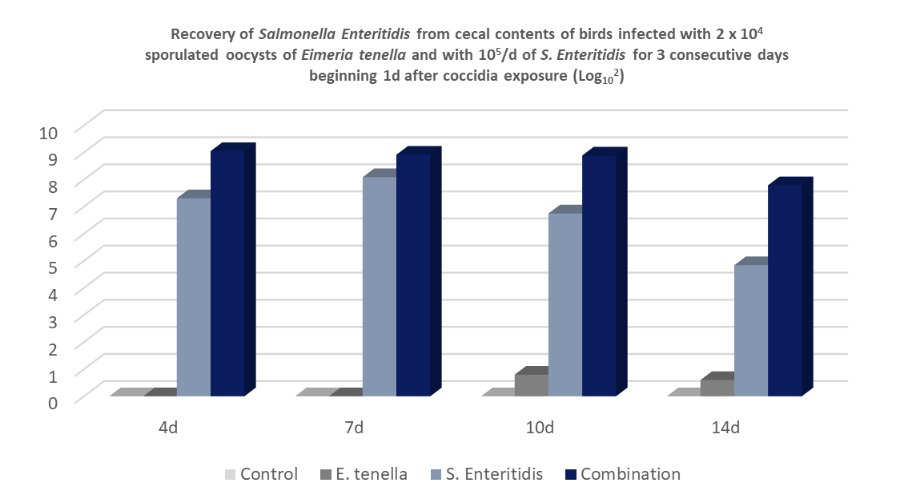Avian coccidiosis in chickens is considered one of the main diseases in poultry production worldwide, causing significant health problems and great economic losses, either in its clinical or subclinical form. On the other hand, Salmonella spp. is one of the most important bacteria that threatens food safety and public health, especially related to poultry products such as meat and eggs. In this article, we will briefly review the relationship between these two intestinal avian pathogens.
Salmonella serotypes that impact on human health (Paratyphoid Salmonella) are motile and facultatively anaerobic. Although paratyphoid infections of poultry are common, they rarely produce acute clinical signs except in highly susceptible birds exposed to stressful situations. More often, paratyphoid infections of poultry are characterized by asymptomatic colonization of the intestinal tract and internal organs such as the liver, spleen and ovaries, potentially leading to carcass contamination, posing a threat to public health.
Effect of Eimeria tenella challenge on Salmonella Enteritidis
The present article1 aimed to study the effect of Eimeria tenella challenge on Salmonella Enteritidis challenge in chickens. For this purpose, 80 one-day-old birds were divided into four groups of 20 birds each, which included a group of uninfected controls, a group infected with E. tenella, a group infected with S. Enteritidis, and a group that received a combination of E. tenella and S. Enteritidis. An inoculum of 105 CFU S. Enteritidis was given daily for three consecutive days, beginning one day after coccidia exposure. Five birds from each group were killed 4, 7, 10, and 14 days after coccidia exposure for bacteriological detection. The liver and spleen were examined separately. 
Factorial analysis of the number of S. Enteritidis in the cecal contents showed that the effects of coccidia, Salmonella, and time, and the interactions of E. tenella by Salmonella, Salmonella by time, and E. tenella by Salmonella by time were significant. Also, there was a significant difference between birds infected with S. Enteritidis alone and birds infected with both E. tenella and S. Enteritidis, except for the birds necropsied 7 d after coccidia exposure. The number of birds positive for S. Enteritidis in liver and spleen in the group concurrently infected with coccidia was greater than that of the group infected with Salmonella alone, but the difference was not significant.
Multiplication of Salmonella Enteritidis
Previous reports2,3 have presented evidences that S. Typhimurium infection could be enhanced by the concurrent infections of E. tenella (Takimoto et al, 1984), or Eimeria necatrix (Stephens and Vestal, 1966). It was evident that the infection of coccidia provided a favorable environment for the multiplication of S. Enteritidis in the ceca. The possible mechanism underlying the enhancement of S. Enteritidis population by cecal coccidiosis remains to be elucidated. However, Baba et al. (1985,1987) indicated that the multiplication of S. Typhimurium in the ceca of chickens inoculated with E. tenella was associated with decreased concentrations of volatile fatty acids and increased oxidation-reduction potential.
References
1. Takimoto H, Baba E, Fukata T, Arakawa A. Effects of infection of Eimeria tenella, E. acervulina, and E. maxima upon Salmonella typhimurium infection in chickens. Poult Sci. 1984 Mar;63(3):478-84. doi: 10.3382/ps.0630478. PMID: 6371754.
https://pubmed.ncbi.nlm.nih.gov/6371754/
2. Arakawa A, Fukata T, Baba E, McDougald LR, Bailey JS, Blankenship LC. Influence of coccidiosis on Salmonella colonization in broiler chickens under floor-pen conditions. Poult Sci. 1992 Jan;71(1):59-63. doi: 10.3382/ps.0710059. PMID: 1539023.
3. Qin ZR, Fukata T, Baba E, Arakawa A. Effect of Eimeria tenella infection on Salmonella enteritidis infection in chickens. Poult Sci. 1995 Jan;74(1):1-7. doi: 10.3382/ps.0740001. PMID: 7899197.



